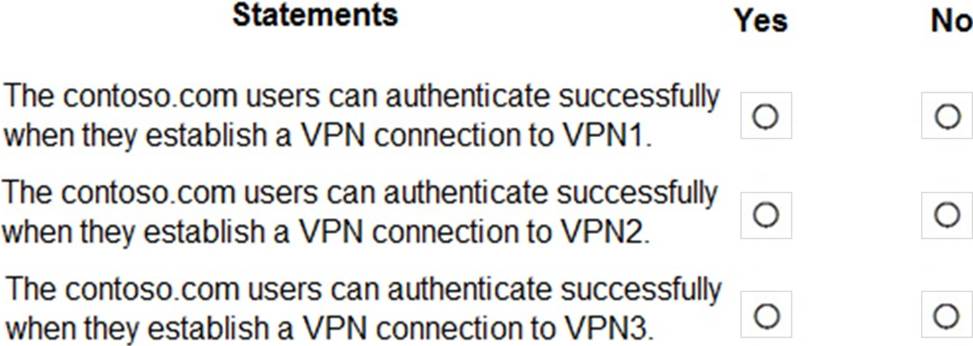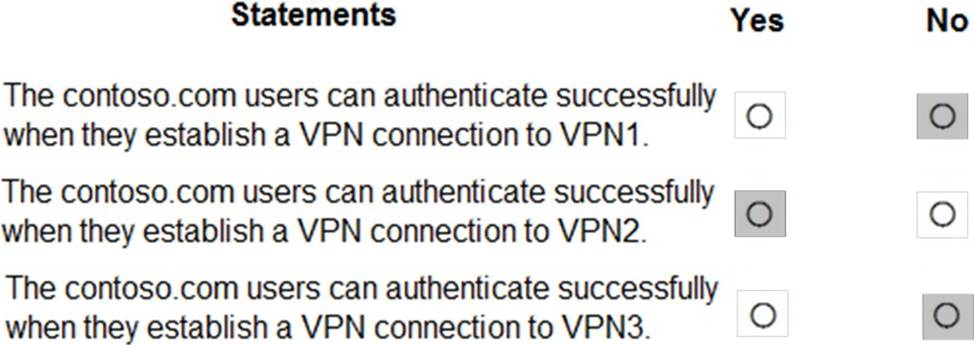Practice Free AZ-800 Exam Online Questions
HOTSPOT
You have a server named Server1 that runs Windows Server and has the Hyper-V server role installed. Server1 contains a virtual machine named VM1 that runs Windows Server. You need to install the Hyper-V server role on VM1.
Which PowerShell command should you run first? To answer, select the appropriate options in the answer area. NOTE: Each correct selection is worth one point.


HOTSPOT
Your network contains an Active Directory Domain Services (AD DS) domain.
The domain contains the servers shown in the following table.

The domain contains the users shown in the following table.

On Server2. you run the Enable-PSRemoting cmdlet
For each of the following statements, select Yes if the statement is true. Otherwise, select No. NOTE: Each correct selection is worth one point.


HOTSPOT
You have a Windows Server container host named Server1 that has a single disk.
On Server1, you plan to start the containers shown in the following table.

Which isolation mode can you use for each container? To answer, select the appropriate options in the answer area. NOTE: Each correct selection is worth one point.
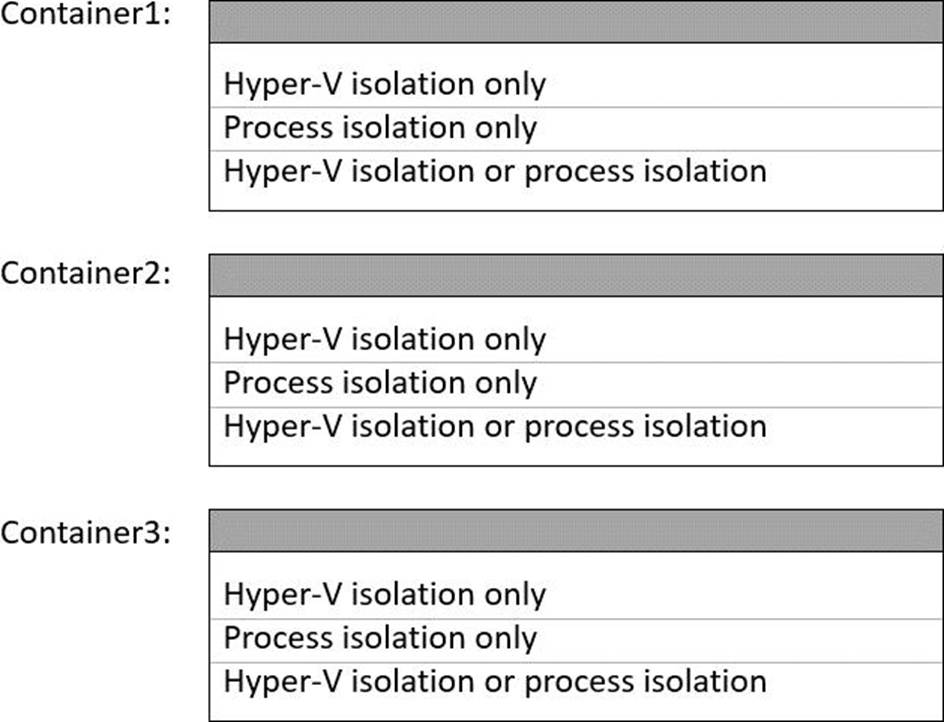
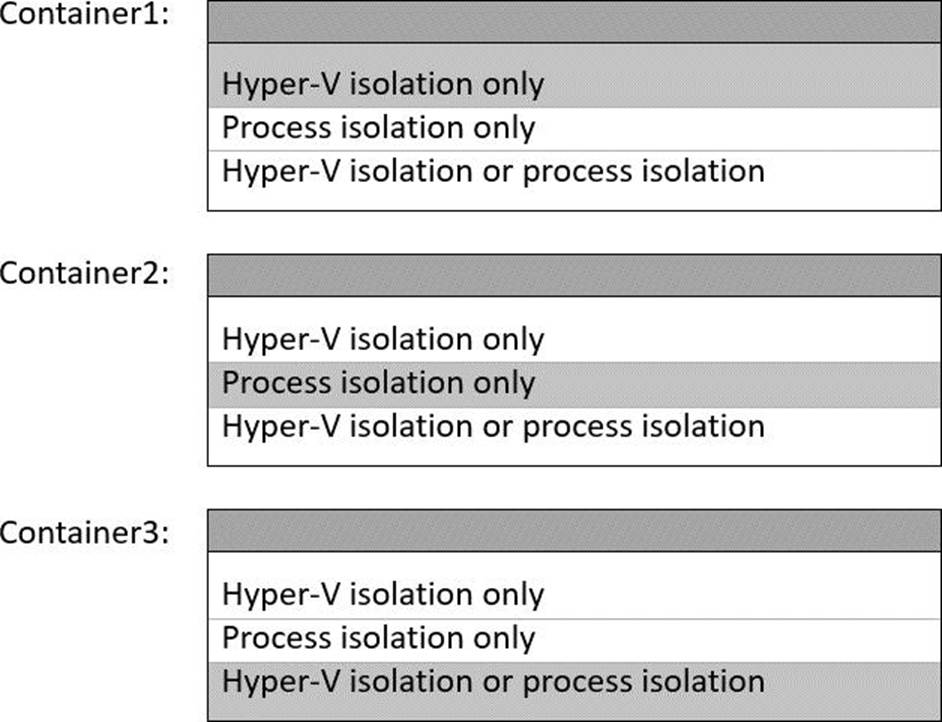
Explanation:
Reference: https://docs.microsoft.com/en-us/virtualization/windowscontainers/manage-containers/hyperv-container
You have a Windows Server container host named Server 1 and a container image named Image1. You need to start a container from image1. The solution must run the container on a Hyper-V virtual machine.
Which parameter should you specify when you run the docker run command?
- A . –expose
- B . –privileged
- C . –runtime
- D . –entrypoint
- E . –isolation
D
Explanation:
Reference: https://docs.microsoft.com/en-us/virtualization/windowscontainers/manage-containers/hyperv-container
SIMULATION
Task 9
You plan to create group managed service accounts (gMSAs).
You need to configure the domain to support the creation of gMSAs.
On a domain controller or a computer that has the Remote Server Administration Tools (RSAT) installed, open PowerShell as an administrator and run the following command to install the Active Directory module:
Install-WindowsFeature -Name RSAT-AD-PowerShell
Run the following command to create a Key Distribution Service (KDS) root key, which is required for generating passwords for gMSAs. You only need to do this once per domain:
Add-KdsRootKey -EffectiveImmediately
Wait for at least 10 hours for the KDS root key to replicate to all domain controllers in the domain. Alternatively, you can use the -EffectiveTime parameter to specify a past date and time for the KDS root key, but this is not recommended for security reasons. For more information, see Add-KdsRootKey.
After the KDS root key is replicated, you can create and configure gMSAs using the New-ADServiceAccount and Set-ADServiceAccount cmdlets. For more information, see Create a gMSA and Configure a gMSA.
HOTSPOT
Your network contains a Microsoft Entra Domain Services domain named sk230128outlook.onmicrosoft.com. The domain contains a server named Server1 that runs Windows Server.
You have the users shown in the following table.

The domain contains the Group Policy Objects (GPOs) shown in the following exhibit.
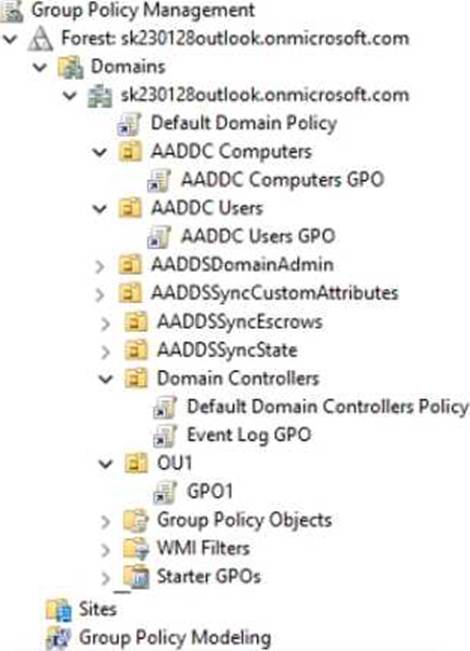
The minimum password length for each GPO is configured as shown in the following table.
For each of the following statements, select Yes if the statement is true. Otherwise, select No. NOTE: Each correct selection is worth one point.


HOTSPOT
You have a Windows Server container host named Server1 and an Azure subscription.
You deploy an Azure container registry named Registry1 to the subscription.
On Server1, you create a container image named image1.
You need to store imager in Registry1.
Which command should you run on Server1? To answer, select the appropriate options in the answer area. NOTE: Each correct selection is worth one point.


Explanation:
Reference: https://docs.microsoft.com/en-us/azure/container-registry/container-registry-get-started-docker-cli?tabs=azure-cli#push-the-image-to-your-registry
SIMULATION
Task 8
You need to create an Active Directory Domain Services (AD DS) site named Site2 that is associated to an IP address range of 192.168.2.0 to 192.168.2.255.
On a domain controller or a computer that has the Remote Server Administration Tools (RSAT) installed, open Active Directory Sites and Services from the Administrative Tools menu or by typing dssite.msc in the Run box.
In the left pane, right-click on Sites and select New Site.
In the New Object – Site dialog box, enter Site2 as the Name of the new site. Select a site link to associate the new site with, such as DEFAULTIPSITELINK, and click OK. You can also create a new site link if you want to customize the replication frequency and schedule between the sites. For more information on how to create a site link, see Create a Site Link.
In the left pane, right-click on Subnets and select New Subnet.
In the New Object – Subnet dialog box, enter 192.168.2.0/24 as the Prefix of the subnet. This notation represents the IP address range of 192.168.2.0 to 192.168.2.255 with a subnet mask of 255.255.255.0. Select Site2 as the Site object to associate the subnet with, and click OK.
Wait for the changes to replicate to other domain controllers. You can verify the site and subnet creation by checking the Sites and Subnets containers in Active Directory Sites and Services.
Now, you have created an AD DS site named Site2 that is associated to an IP address range of 192.168.2.0 to 192.168.2.255. You can add domain controllers to the new site and configure the site links and site link bridges to optimize the replication topology.
You have an on-premises server named Server! that runs Windows Server. You have an Azure subscription that contains a virtual network named VNet1. You need to connect Server! to VNet1 by using Azure Network Adapter.
What should you use?
- A . Azure AD Connect
- B . Device Manager
- C . the Azure portal
- D . Windows Admin Center
HOTSPOT
Your network contains an Active Directory Domain Services (AD DS) domain named contoso.com.
The domain contains the VPN servers shown in the following table.

You have a server named NPS1 that has Network Policy Server (NPS) installed.
NPS1 has the following RADIUS clients:
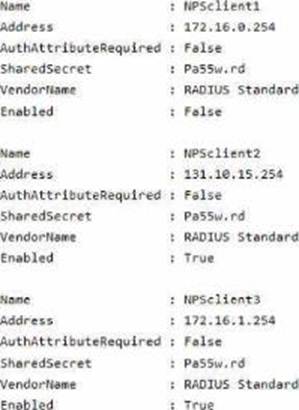
VPN1, VPN2, and VPN3 use NPS1 for RADIUS authentication. All the users in contoso.com are allowed to establish VPN connections.
For each of the following statements, select Yes If the statement is true. Otherwise, select No. NOTE: Each correct selection is worth one point.
